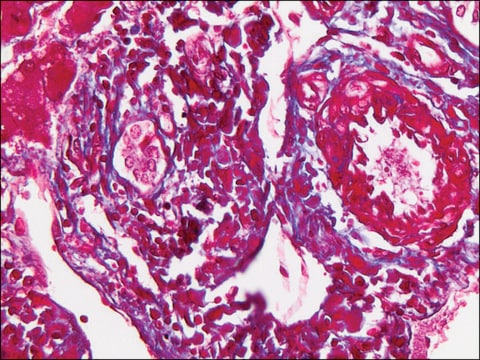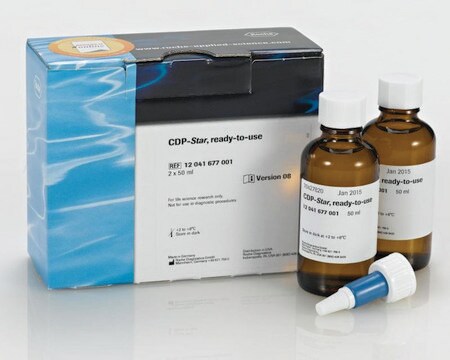推荐产品
生物源
mouse
品質等級
抗體表格
purified antibody
抗體產品種類
primary antibodies
無性繁殖
49569, monoclonal
分子量
calculated mol wt 25.820 kDa
observed mol wt ~24 kDa
純化經由
using protein G
物種活性
mouse
包裝
antibody small pack of 100
技術
immunofluorescence: suitable
immunohistochemistry: suitable
western blot: suitable
同型
IgG2aκ
表位序列
Cytoplasmic domain
Protein ID登錄號
UniProt登錄號
儲存溫度
2-8°C
基因資訊
mouse ... Lrat(79235)
特異性
Clone 49569 is a mouse monoclonal antibody that detects LRAT. It targets an epitope within 91 amino acids from the cytoplasmic domain of the protein.
免疫原
His-tagged recombinant mouse LRAT fragment corresponding to 91 amino acids from the cytoplasmic domain of mouse LRAT.
應用
Quality Control Testing
Evaluated by Western Blotting in mouse retina lysate.
Western Blotting Analysis: A 1:1,000 dilution of this antibody detected LRAT in mouse retina tissue lysate.
Tested Applications
Western Blotting Analysis: A 1:1,000 dilution from a representative lot detected LRAT in Retinal pigment epithelium (RPE) microsome lysate.
Immunofluorescence Analysis: A representative lot detected LRAT in Immunofluorescence applications (Batten, M.L., et al. (2004). J. Biol. Chem. 279(11):10422-32; Moise, A.R., et al. (2007). J Biol Chem. 282(3):2081-90).
Immunohistochemistry Analysis: A representative lot detected LRAT in Immunohistochemistry applications (Batten, M.L., et al. (2004). J. Biol. Chem. 279(11):10422-32; Moise, A.R., et al. (2007). J Biol Chem. 282(3):2081-90).
Western Blotting Analysis: A representative lot detected LRAT in Western Blotting applications (Batten, M.L., et al. (2004). J Biol Chem. 279(11):10422-32; Moise, A.R., et al. (2007). J. Biol. Chem. 282(3):2081-90).
Note: Actual optimal working dilutions must be determined by end user as specimens, and experimental conditions may vary with the end user.
Evaluated by Western Blotting in mouse retina lysate.
Western Blotting Analysis: A 1:1,000 dilution of this antibody detected LRAT in mouse retina tissue lysate.
Tested Applications
Western Blotting Analysis: A 1:1,000 dilution from a representative lot detected LRAT in Retinal pigment epithelium (RPE) microsome lysate.
Immunofluorescence Analysis: A representative lot detected LRAT in Immunofluorescence applications (Batten, M.L., et al. (2004). J. Biol. Chem. 279(11):10422-32; Moise, A.R., et al. (2007). J Biol Chem. 282(3):2081-90).
Immunohistochemistry Analysis: A representative lot detected LRAT in Immunohistochemistry applications (Batten, M.L., et al. (2004). J. Biol. Chem. 279(11):10422-32; Moise, A.R., et al. (2007). J Biol Chem. 282(3):2081-90).
Western Blotting Analysis: A representative lot detected LRAT in Western Blotting applications (Batten, M.L., et al. (2004). J Biol Chem. 279(11):10422-32; Moise, A.R., et al. (2007). J. Biol. Chem. 282(3):2081-90).
Note: Actual optimal working dilutions must be determined by end user as specimens, and experimental conditions may vary with the end user.
標靶描述
Lecithin retinol acyltransferase (UniProt: Q9JI60) (also known as EC:2.3.1.135) is encoded by the Lrat gene (Gene ID:79235) in mouse. Lecithin-retinol acyltransferase (LRAT) is an essential enzyme involved in the metabolism of retinoids, particularly vitamin A. LRAT contains a conserved domain crucial for its enzymatic activity. The primary function of LRAT is to catalyze the esterification of retinol to produce retinyl esters, a process vital for the storage and transport of vitamin A within the body. LRAT′s plays a role in the visual cycle as it contributes to the regeneration of visual pigments in the retina. The expression of LRAT is regulated by dietary vitamin A levels, and it is found in various tissues, including the liver, lungs, testis, and the eye. LRAT is primarily localized to the endoplasmic reticulum. Mutations in the LRAT gene have been linked to a form of retinitis pigmentosa, an inherited retinal disease associated with progressive vision loss.
外觀
Purified mouse monoclonal antibody IgG2a in buffer containing 0.1 M Tris-Glycine (pH 7.4), 150 mM NaCl with 0.05% sodium azide.
重構
1.0 mg/mL. Please refer to guidance on suggested starting dilutions and/or titers per application and sample type.
儲存和穩定性
Recommended storage: +2°C to +8°C.
其他說明
Concentration: Please refer to the Certificate of Analysis for the lot-specific concentration.
免責聲明
Unless otherwise stated in our catalog or other company documentation accompanying the product(s), our products are intended for research use only and are not to be used for any other purpose, which includes but is not limited to, unauthorized commercial uses, in vitro diagnostic uses, ex vivo or in vivo therapeutic uses or any type of consumption or application to humans or animals.
未找到合适的产品?
试试我们的产品选型工具.
我们的科学家团队拥有各种研究领域经验,包括生命科学、材料科学、化学合成、色谱、分析及许多其他领域.
联系技术服务部门







